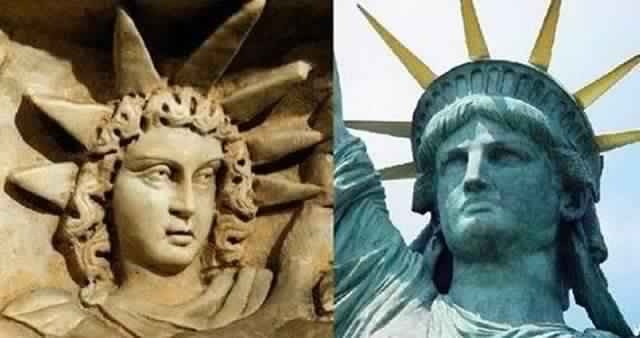Not at all.If i may comment.There is no such thing as coincidence in the the path “they” walk.Or to put it more broadly, there is no such thing as coincidence. Not here. Not in this world. 
With the advent of AI in art, we have to have the name of the original painting and painter and the year, or its fake. sorry but a certain rigorousness needs to become standard now. However I don’t doubt that the painting is real, I just need to see proof.
Satan summoning his Legions, 1796-1797
Sir Thomas Lawrence PRA (1769 - 1830)
There are a lot of major differences between this painting and the statue of liberty, but they both have at least one arm raised, so that is why they are being compared?
Possible meanings (From British Royal Academy)
David Bindman does not discuss Lawrence’s picture specifically, but suggests that for English artists in the 1790s, Satan’s ‘heroic defiance of the Almighty could be taken as a model of resistance to a distant and arbitrary power… The French Revolution, especially as it passed beyond the stage when English radicals could regard it as a new dawn for humanity, began to appear even more Miltonic, as destruction, chaos and envy seemed to attend it, as they did Satan on his travels across the universe. Milton could be seen, depending on one’s degree of revolutionary commitment, as a prophet of Revolution, who had foreseen its inevitable collapse into tyranny, or alternatively had witnessed its hard and painful progress before it could achieve its aims.’ (David Bindman, The Shadow of the Guillotine, Britain and the French Revolution, exh cat, British Museum Publications, 1989, p166)
Michael Levey instead prefers a contextualisation based on Lawrence’s childhood interest in Paradise Lost ‘which can be said from childhood to have haunted Lawrence’. Levey saw the painting before it was conserved, ‘No amount of darkened varnish and discoloured paint can conceal the imperious pose of Satan’s naked, muscular figure, with arms upraised and eyes glaring out from a helmeted head. The rest of the composition must always have been shadowy, intentionally subordinated to that single form.’ (Levey 2005, p129)
Critical responses
The painting has a reputation for being a critical failure. The outspoken critic and satirist Anthony Pasquin wrote:
‘The frequency with which we have been annually compelled to notice the daring folly of our callous Artistes, in assuming the baton of an historical Painter, before they had even a common knowledge of the human anatomy, has filled us with regret, yet it appears, that no warning can refrain their lunacy, nor any admonition amend their manners:- before Michel Angelo, or Rafaelle, attempted to walk in this path of sublimity, they added the force of incalculable and unremitting study to the purest and strongest endowments, and even then they took up the pencil tremblingly, well knowing the complicated difficulties of the pursuit. “But fools rush in, when angels fear to tread.” The picture is a melange, made up of the worst parts of the divine Bonarotti [ie Michelangelo], and the extravagant Goltzius: the figure of Satan is colossal and very ill drawn: the body is so disproportioned to the extremities, that it appears all legs and arms, and might, at a distance, be mistaken for a sign of the spread eagle. The colouring has little analogy to truth as the contour, for it is so ordered that it conveys an idea of a mad German baker, dancing naked in a conflagration of his own treacle! (A.P. [Anthony Pasquin] Royal Academy. Twenty-Ninth Exhibition, [1797] In Royal Academy Critiques, Vol. II, p10)
Excellent!
I think the faces look remarkably similar. You’d say they were in the same family if they were people.
Nope, probably not a koinkydink.


